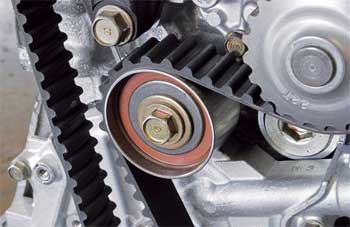Timing Belt

In the internal combustion engine application the timing belt/chain connects the crankshaft to the camshaft(s), which in turn controls the opening and closing of the engine's valves. A four-stroke engine requires that the valves open and close once every other revolution of the crankshaft. The timing belt/chain does this. It has teeth to turn the camshaft(s) synchronised with the crankshaft, and is specifically designed for a particular engine. In some engine designs the timing belt may also be used to drive other engine components such as the water pump and oil pump.
Gear or chain systems are also used to connect the crankshaft to the camshaft at the correct timing. However, gears and shafts constrain the relative location of the crankshaft and camshafts. Even where the crankshaft and camshaft(s) are very close together, as in pushrod engines, most engine designers use a short chain drive rather than a direct gear drive. This is because gear drives suffer from frequent torque reversal as the cam profiles "kick back" against the drive from the crank, leading to excessive noise and wear. Fibre gears, with more resilience, are preferred to steel gears where direct drive has to be used. Even though the "official" purpose of fiber or nylon gears may be to deal with "kickback", a fiber or nylon cam gear is cheaper to produce. Steel gears almost never fail. The cam lobes wear out long before the gears do. Most large truck and industrial diesel engines have steel gears, and they go 300,000 to 500,000 miles without gears failing. In fact, usually the only time a direct-gear cam drive setup will fail is when the cam gear is nylon or fiber.
A belt or chain allows much more flexibility in the relative locations of the crankshaft and camshafts.
While chains and gears may be more durable, rubber composite belts are quieter in their operation (in most modern engines the noise difference is negligible), are less expensive and more efficient, by dint of being lighter, when compared with a gear or chain system. Also, timing belts do not require lubrication, which is essential with a timing chain or gears. A timing belt is a specific application of a synchronous belt used to transmit rotational power synchronously.
Timing belts are typically covered by metal or polymer timing belt covers which require removal for inspection or replacement. Engine manufacturers recommend replacement at specific intervals. The manufacturer may also recommend the replacement of other parts, such as the water pump, when the timing belt is replaced because the additional cost to replace the water pump is negligible compared to the cost of accessing the timing belt. In an interference engine, or one whose valves extend into the path of the piston, failure of the timing belt (or timing chain) invariably results in costly and, in some cases, irreparable engine damage, as some valves will be held open when they should not be and thus will be struck by the pistons.
Indicators that the timing chain may need to be replaced include a rattling noise from the front of the engine.